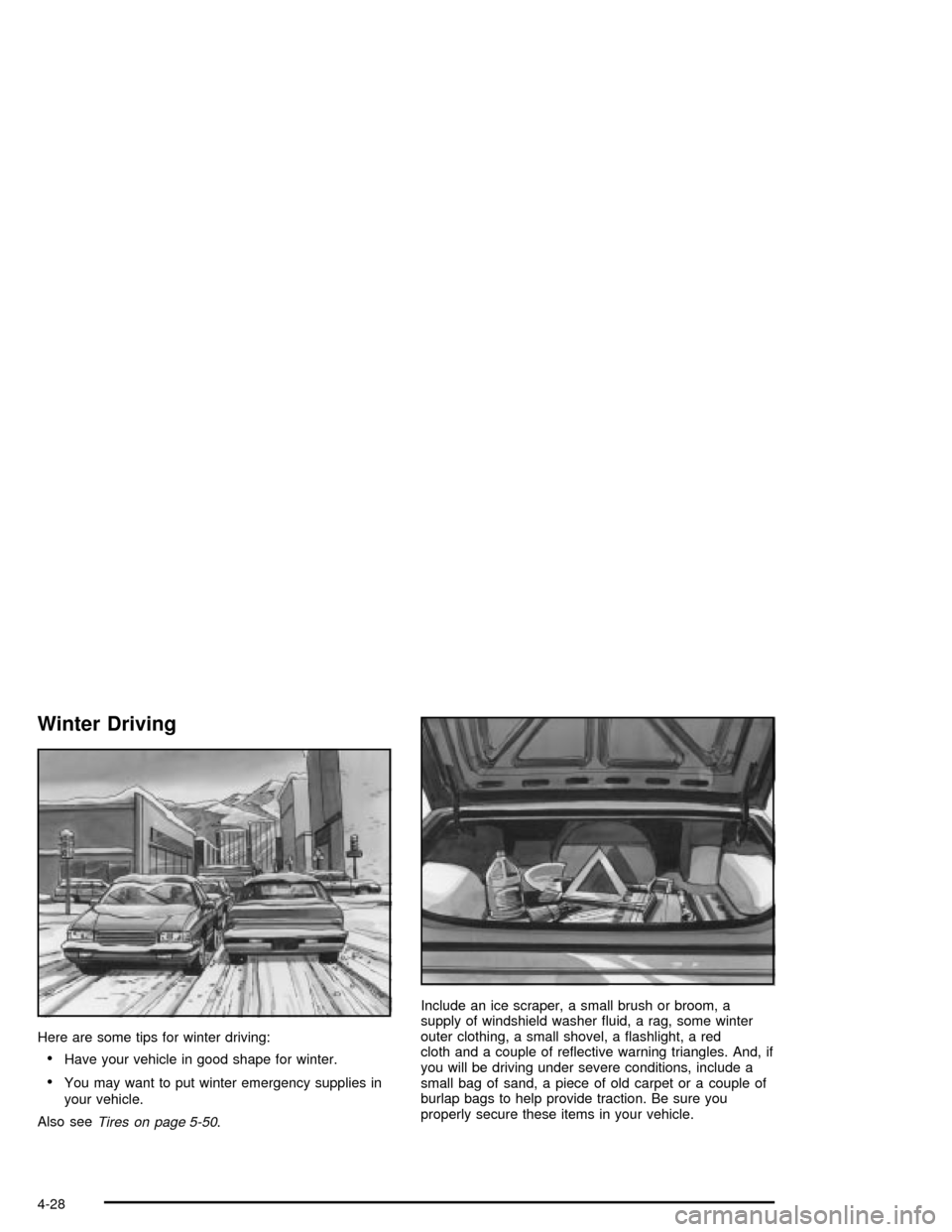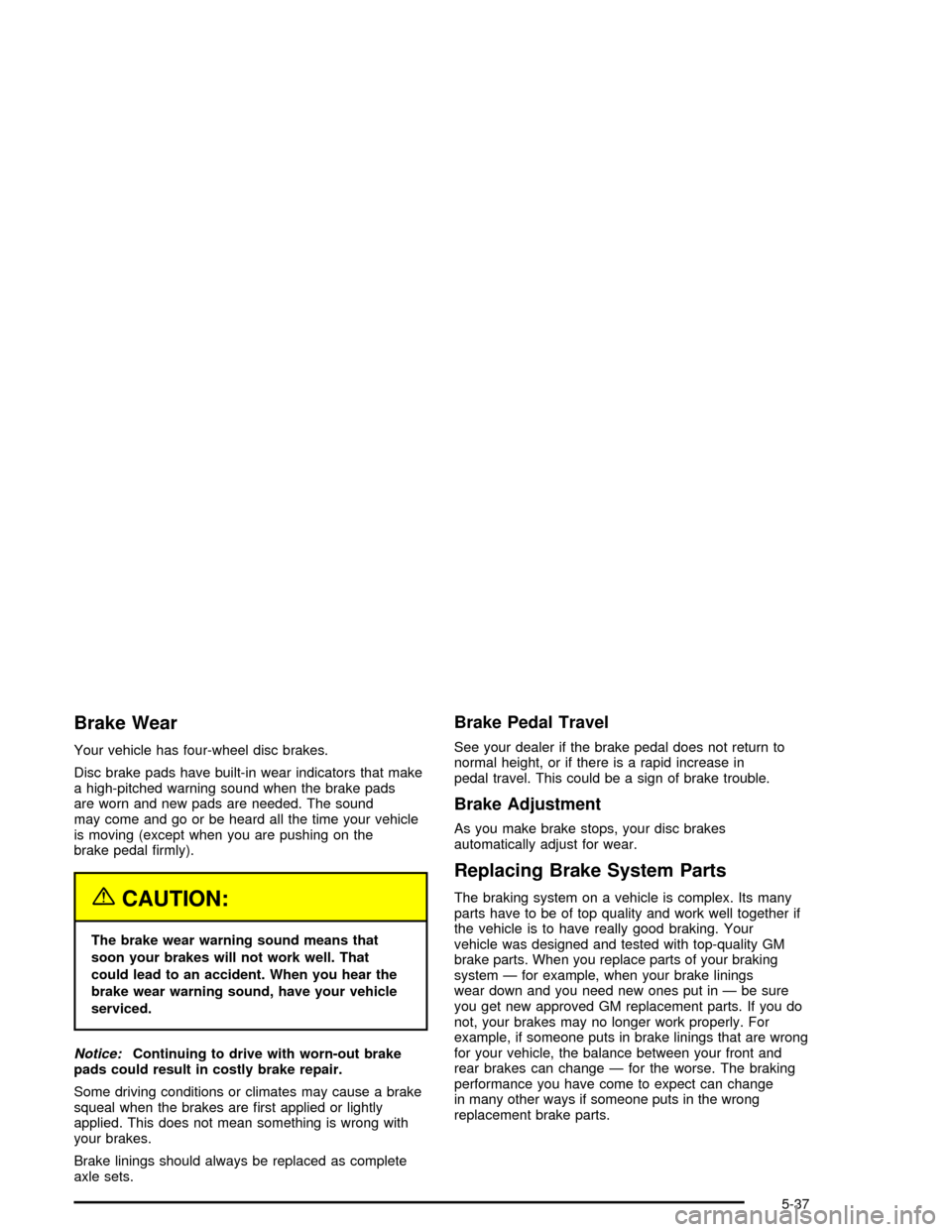warning light CADILLAC XLR 2004 1.G Owner's Manual
[x] Cancel search | Manufacturer: CADILLAC, Model Year: 2004, Model line: XLR, Model: CADILLAC XLR 2004 1.GPages: 356, PDF Size: 2.36 MB
Page 207 of 356

City DrivingOne of the biggest problems with city streets is the
amount of traffic on them. You will want to watch out for
what the other drivers are doing and pay attention to
traffic signals.
Here are ways to increase your safety in city driving:
·Know the best way to get to where you are
going. Get a city map and plan your trip into
an unknown part of the city just as you would for a
cross-country trip.
·Try to use the freeways that rim and crisscross
most large cities. You will save time and energy.
See
Freeway Driving on page 4-24.
·Treat a green light as a warning signal. A traffic
light is there because the corner is busy enough
to need it. When a light turns green, and just before
you start to move, check both ways for vehicles
that have not cleared the intersection or may
be running the red light.
4-23
Page 212 of 356

Winter Driving
Here are some tips for winter driving:
·Have your vehicle in good shape for winter.
·You may want to put winter emergency supplies in
your vehicle.
Also see
Tires on page 5-50.Include an ice scraper, a small brush or broom, a
supply of windshield washer ¯uid, a rag, some winter
outer clothing, a small shovel, a ¯ashlight, a red
cloth and a couple of re¯ective warning triangles. And, if
you will be driving under severe conditions, include a
small bag of sand, a piece of old carpet or a couple of
burlap bags to help provide traction. Be sure you
properly secure these items in your vehicle.
4-28
Page 239 of 356

How to Reset the CHANGE OIL NOW
Message and the Oil Life Indicator
The GM Oil Life System calculates when to change
your engine oil and ®lter based on vehicle use. Anytime
your oil is changed, reset the system so it can
calculate when the next oil change is required. If a
situation occurs where you change your oil prior to a
CHANGE OIL NOW message in the DIC being
turned on, reset the system.
After the oil has been changed, the CHANGE OIL NOW
message and the oil life indicator must be reset. To
reset the message use the following procedure:
1. Press the up or down arrow to scroll the DIC to
show OIL LIFE.
2. Once the XXX% ENGINE OIL LIFE menu item is
highlighted, press and hold the RESET button until
the percentage shows 100%.
If the percentage does not return to 100% or if the
CHANGE OIL NOW message comes back on
when you start your vehicle, the engine oil
life system has not reset. Repeat the procedure.
What to Do with Used Oil
Used engine oil contains certain elements that may be
unhealthy for your skin and could even cause cancer.
Do not let used oil stay on your skin for very long. Clean
your skin and nails with soap and water, or a good
hand cleaner. Wash or properly dispose of clothing or
rags containing used engine oil. See the manufacturer's
warnings about the use and disposal of oil products.
Used oil can be a threat to the environment. If you
change your own oil, be sure to drain all the oil from the
®lter before disposal. Never dispose of oil by putting it
in the trash, pouring it on the ground, into sewers, or into
streams or bodies of water. Instead, recycle it by
taking it to a place that collects used oil. If you have a
problem properly disposing of your used oil, ask
your dealer, a service station or a local recycling center
for help.
5-17
Page 242 of 356

Notice:We recommend you use only ¯uid labeled
DEXRONž-III, because ¯uid with that label is
made especially for your automatic transmission.
Damage caused by ¯uid other than DEXRON
ž-III is
not covered by your new vehicle warranty.
Change both the ¯uid and ®lter every 50,000 miles
(80 000 km) if the vehicle is mainly driven under one of
these conditions:
·In heavy city traffic where the outside temperature
regularly reaches 90ÉF (32ÉC) or higher.
·In hilly or mountainous terrain.
·High performance operation.
If you do not use your vehicle under one of these
conditions, change the ¯uid and ®lter every
100,000 miles (166 000 km).
See
Scheduled Maintenance on page 6-4for the proper
service intervals for the transmission ¯uid and ®lter.
Engine Coolant
The cooling system in your vehicle is ®lled with
DEX-COOLžengine coolant. This coolant is designed
to remain in your vehicle for 5 years or 150,000 miles
(240 000 km), whichever occurs ®rst, if you add
only DEX-COOL
žextended life coolant.The following explains your cooling system and how to
add coolant when it is low. If you have a problem
with engine overheating, see
Engine Overheating on
page 5-23.
A 50/50 mixture of clean, drinkable water and
DEX-COOL
žcoolant will:
·Giving freezing protection down to-34É F-37É C.
·Give boiling protection up to 265É F (129É C).
·Protect against rust and corrosion.
·Help keep the proper engine temperature.
·Let the warning lights and gages work as they
should.
Notice:Using coolant other than DEX-COOLžmay
cause premature engine, heater core or radiator
corrosion. In addition, the engine coolant may
require changing sooner, at 30,000 miles (50 000 km)
or 24 months, whichever occurs ®rst. Any repairs
would not be covered by your warranty. Always use
DEX-COOL
ž(silicate-free) coolant in your vehicle.
5-20
Page 259 of 356

Brake Wear
Your vehicle has four-wheel disc brakes.
Disc brake pads have built-in wear indicators that make
a high-pitched warning sound when the brake pads
are worn and new pads are needed. The sound
may come and go or be heard all the time your vehicle
is moving (except when you are pushing on the
brake pedal ®rmly).
{CAUTION:
The brake wear warning sound means that
soon your brakes will not work well. That
could lead to an accident. When you hear the
brake wear warning sound, have your vehicle
serviced.
Notice:Continuing to drive with worn-out brake
pads could result in costly brake repair.
Some driving conditions or climates may cause a brake
squeal when the brakes are ®rst applied or lightly
applied. This does not mean something is wrong with
your brakes.
Brake linings should always be replaced as complete
axle sets.
Brake Pedal Travel
See your dealer if the brake pedal does not return to
normal height, or if there is a rapid increase in
pedal travel. This could be a sign of brake trouble.
Brake Adjustment
As you make brake stops, your disc brakes
automatically adjust for wear.
Replacing Brake System Parts
The braking system on a vehicle is complex. Its many
parts have to be of top quality and work well together if
the vehicle is to have really good braking. Your
vehicle was designed and tested with top-quality GM
brake parts. When you replace parts of your braking
system Ð for example, when your brake linings
wear down and you need new ones put in Ð be sure
you get new approved GM replacement parts. If you do
not, your brakes may no longer work properly. For
example, if someone puts in brake linings that are wrong
for your vehicle, the balance between your front and
rear brakes can change Ð for the worse. The braking
performance you have come to expect can change
in many other ways if someone puts in the wrong
replacement brake parts.
5-37
Page 281 of 356

A low tire warning light also appears on the instrument
panel cluster when a low tire condition exists. The
DIC message, CHECK TIRE PRESSURE and the low
tire pressure warning light will be shown each time
the engine is started and stay on until the low tire
condition is corrected.
When the tire pressure
monitoring system warning
light is lit, one or more
of your tires is signi®cantly
under-in¯ated.
You should stop and check your tires as soon as
possible, and in¯ate them to the proper pressure as
indicated on the vehicle's tire information placard.
Driving on a signi®cantly under-in¯ated tire causes the
tire to overheat and can lead to tire failure.
Under-in¯ation also reduces fuel efficiency and tire tread
life, and may affect the vehicle's handling and stopping
ability. Each tire, including the spare, should be
checked monthly when cold and set to the
recommended in¯ation pressure as speci®ed in the
vehicle placard and owner's manual.The Tire and Loading Information Label (tire information
placard) is either on the rear edge of the driver's door
or the driver's door jamb near the latch. This label shows
the size of your vehicle's original tires and the correct
in¯ation pressure for your vehicle's tires when they
are cold. See
In¯ation - Tire Pressure on page 5-57.
Your vehicle's TPM system can alert you about a low or
high tire pressure condition but it does not replace
normal tire maintenance. See
Tire Inspection and
Rotation on page 5-60
Each TPM sensor has a unique identi®cation code that
is matched to one of the four tire positions on your
vehicle. The tire and wheel assembly positions are, left
front (LF); right front (RF); right rear (RR) and left
rear (LR). Any time you rotate your vehicle's tires or
replace one or more TPM sensors, the identi®cation
codes will need to be matched to the new tire and wheel
position. The TPM matching process is performed in
a speci®c sequence and time limit. A special tool is also
required. See your dealer for service.
The SVC TIRE MONITOR message is displayed when
the TPM system is malfunctioning. For example,
one or more TPM sensors may be inoperable or
missing. See your dealer for service.
5-59
Page 286 of 356

Uniform Tire Quality Grading
Quality grades can be found where applicable on the
tire sidewall between tread shoulder and maximum
section width. For example:
Treadwear 200 Traction AA Temperature A
The following information relates to the system
developed by the United States National Highway
Traffic Safety Administration, which grades tires by
treadwear, traction and temperature performance. (This
applies only to vehicles sold in the United States.)
The grades are molded on the sidewalls of most
passenger car tires. The Uniform Tire Quality Grading
system does not apply to deep tread, winter-type
snow tires, space-saver or temporary use spare tires,
tires with nominal rim diameters of 10 to 12 inches
(25 to 30 cm), or to some limited-production tires.
While the tires available on General Motors passenger
cars and light trucks may vary with respect to these
grades, they must also conform to federal safety
requirements and additional General Motors Tire
Performance Criteria (TPC) standards.
Treadwear
The treadwear grade is a comparative rating based on
the wear rate of the tire when tested under controlled
conditions on a speci®ed government test course.
For example, a tire graded 150 would wear one and
a half (1.5) times as well on the government course as
a tire graded 100. The relative performance of tires
depends upon the actual conditions of their use,
however, and may depart signi®cantly from the norm
due to variations in driving habits, service practices and
differences in road characteristics and climate.
Traction ± AA, A, B, C
The traction grades, from highest to lowest, are AA, A,
B, and C. Those grades represent the tire's ability
to stop on wet pavement as measured under controlled
conditions on speci®ed government test surfaces of
asphalt and concrete. A tire marked C may have poor
traction performance. Warning: The traction grade
assigned to this tire is based on straight-ahead braking
traction tests, and does not include acceleration,
cornering, hydroplaning, or peak traction characteristics.
5-64
Page 343 of 356

A
Accessory Power Outlets.................................3-32
Adaptive Cruise Control (ACC)........................... 3-9
Adding Washer Fluid.......................................5-34
Additional Program Information........................... 7-8
Additives, Fuel................................................. 5-6
Add-On Electrical Equipment............................5-84
Air Bag
Off Light.....................................................3-43
Readiness Light..........................................3-42
Air Bag Systems.............................................1-36
Air Bag Off Switch.......................................1-44
How Does an Air Bag Restrain?....................1-42
Servicing Your Air Bag-Equipped Vehicle.........1-48
What Makes an Air Bag In¯ate?....................1-42
What Will You See After an Air
Bag In¯ates?...........................................1-42
When Should an Air Bag In¯ate?...................1-41
Where Are the Air Bags?..............................1-38
Air Cleaner/Filter, Engine.................................5-18
Airbag Sensing and Diagnostic Module (SDM)...... 7-8
AM ...............................................................3-72
Antenna, Diversity Antenna System...................3-73
Antenna, XMŸ Satellite Radio
Antenna System..........................................3-73
Anti-lock Brake System (ABS)............................ 4-7
Anti-Lock Brake, System Warning Light..............3-46Appearance Care............................................5-75
Care of Safety Belts....................................5-78
Chemical Paint Spotting...............................5-81
Cleaning the Inside of Your Vehicle................5-75
Cleaning the Outside of Your Vehicle..............5-78
Finish Damage............................................5-80
Underbody Maintenance...............................5-81
Vehicle Care/Appearance Materials................5-82
Weatherstrips..............................................5-78
Approach Lights.............................................3-67
Arming the System.........................................2-17
Ashtrays........................................................3-33
Audio System(s).............................................3-70
Audio Steering Wheel Controls......................3-71
Care of Your CD Player...............................3-72
Care of Your CDs........................................3-72
Diversity Antenna System.............................3-73
Navigation/Radio System..............................3-71
Theft-Deterrent Feature................................3-71
Understanding Radio Reception.....................3-72
XMŸ Satellite Radio Antenna System............3-73
Auto Exit Recall..............................................3-67
Auto Recall....................................................3-67
Auto Unlock...................................................3-69
Automatic Transmission
Fluid..........................................................5-19
Operation...................................................2-23
1
Page 344 of 356

B
Battery..........................................................5-38
Battery Replacement......................................... 2-7
Battery Run-Down Protection............................3-26
Before Leaving on a Long Trip.........................4-25
Brake
Parking......................................................2-26
System Warning Light..................................3-45
Brake Fluid....................................................5-35
Brake Wear...................................................5-37
Brakes..........................................................5-35
Braking........................................................... 4-6
Braking in Emergencies..................................... 4-8
Break-In, New Vehicle.....................................2-19
Bulb Replacement...........................................5-49
Headlamp Aiming........................................5-46
Buying New Tires...........................................5-63
C
Cadillac Owner PrivilegesŸ............................... 7-6
California Fuel.................................................. 5-6
Canada ± Customer Assistance.......................... 7-4
Canadian Owners................................................ ii
Capacities and Speci®cations............................5-91Carbon Monoxide...................2-11, 2-31, 4-28, 4-37
Care of
Safety Belts................................................5-78
Your CD Player...........................................3-72
Your CDs ...................................................3-72
Cellular Phone Usage......................................3-72
Center Console Storage Area...........................2-41
Chains, Tires..................................................5-68
Check Engine Light.........................................3-48
Checking Coolant............................................5-22
Checking Engine Oil........................................5-13
Checking Things Under the Hood......................5-10
Chemical Paint Spotting...................................5-81
Child Restraints
Child Restraint Systems...............................1-23
Infants and Young Children...........................1-20
Lower Anchorages and Top Tethers for
Children (LATCH System)..........................1-27
Older Children.............................................1-18
Securing a Child Restraint Designed for
the LATCH System...................................1-29
Securing a Child Restraint in the
Passenger Seat Position...........................1-31
Top Strap...................................................1-27
Cigarette Lighter.............................................3-33
2
Page 346 of 356

Doing Your Own Service Work........................... 5-4
Door
Locks.......................................................... 2-8
Power Door Locks.......................................2-10
Programmable Automatic Door Locks.............2-10
Driver
Position, Safety Belt.....................................1-10
Driver Information Center (DIC).........................3-55
DIC Controls and Displays............................3-55
DIC Vehicle Personalization..........................3-66
DIC Warnings and Messages........................3-57
Other Messages..........................................3-65
Driver Shift Control.........................................2-25
Driving
At Night.....................................................4-18
City...........................................................4-23
Defensive..................................................... 4-2
Drunken....................................................... 4-2
Freeway.....................................................4-24
Hill and Mountain Roads..............................4-26
In Rain and on Wet Roads...........................4-20
Winter........................................................4-28
Driving On Snow or Ice...................................4-29
Driving Through Deep Standing Water...............4-22
Driving Through Flowing Water.........................4-22
Dual Climate Control System............................3-33E
Eight-Way Power Seats..................................... 1-2
Electrical System
Add-On Equipment......................................5-84
Fuses and Circuit Breakers...........................5-85
Power Windows and Other Power Options......5-84
Windshield Wiper Fuses...............................5-84
Emergency Trunk Release Handle.....................2-14
Emissions Inspection and Maintenance
Programs...................................................3-51
Engine
Air Cleaner/Filter.........................................5-18
Battery.......................................................5-38
Check and Service Engine Soon Light............3-48
Coolant......................................................5-20
Coolant Heater............................................2-21
Coolant Temperature Gage...........................3-47
Drive Belt Routing.......................................6-13
Engine Compartment Overview......................5-12
Exhaust.....................................................2-31
Oil .............................................................5-13
Oil Pressure Gage.......................................3-52
Overheating................................................5-23
Starting......................................................2-20
Engine Oil Additives........................................5-16
4